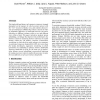Free Online Productivity Tools
i2Speak
i2Symbol
i2OCR
iTex2Img
iWeb2Print
iWeb2Shot
i2Type
iPdf2Split
iPdf2Merge
i2Bopomofo
i2Arabic
i2Style
i2Image
i2PDF
iLatex2Rtf
Sci2ools
ISCA
2000
IEEE
2000
IEEE
Memory access scheduling
The bandwidth and latency of a memory system are strongly dependent on the manner in which accesses interact with the “3-D” structure of banks, rows, and columns characteristic of contemporary DRAM chips. There is nearly an order of magnitude difference in bandwidth between successive references to different columns within a row and different rows within a bank. This paper introduces memory access scheduling, a technique that improves the performance of a memory system by reordering memory references to exploit locality within the 3-D memory structure. Conservative reordering, in which the first ready reference in a sequence is performed, improves bandwidth by 40% for traces from five media benchmarks. Aggressive reordering, in which operations are scheduled to optimize memory bandwidth, improves bandwidth by 93% for the same set of applications. Memory access scheduling is particularly important for media processors where it enables the processor to make the most efficient use of...
Related Content
| Added | 31 Jul 2010 |
| Updated | 31 Jul 2010 |
| Type | Conference |
| Year | 2000 |
| Where | ISCA |
| Authors | Scott Rixner, William J. Dally, Ujval J. Kapasi, Peter R. Mattson, John D. Owens |
Comments (0)

